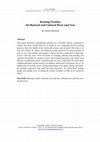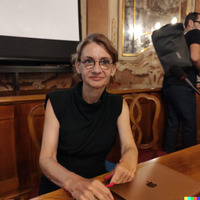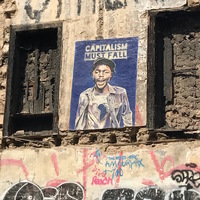Papers by Anneli Palmsköld

Journal of American Folklore, Apr 1, 2020
Craft is a sphere of activities where humans as cultural beings can dwell, a place in people’s li... more Craft is a sphere of activities where humans as cultural beings can dwell, a place in people’s lives where processing of thoughts and feelings regarding everyday life and political events can take place. Craft as cultural heritage can also be directed toward the future, since understanding of handmade processes is a base for industrial production. It is a space for dreaming and planning as well as for material encounters between body and matter—in both ways changing the world. Dwelling in craft must not be idealized, though. Its manifold expressions and opposite features have to be studied critically. Craftwork can be apprehended in various ways: calming but also frustrating, creative, and innovative, as well as boringly routinized. People can earn their living through craft, or they can reside in craft contexts like educational workshops, the DIY or DIT movement, and maker spaces for recreational purposes. Craft can be about healthy people’s creative self-expressions, but it can also be used as a tool in therapeutic processes or in reminiscence work with persons who have dementia. Craft is social when learned and shared but often individually performed with personal bodily knowing as its prerequisite. Thus, it connects people and fosters self-esteem, but it also pinpoints differences regarding bodily performances and may lead to competition and envy. An ethnological “double glance” at the phenomenon is needed. We invite scholars to theorize on craft/making as cultural activities or to present empirical findings from the field.

Culture Unbound: Journal of Current Cultural Research, Mar 12, 2015
This article discusses contemporary practices in a Swedish context, connected to clothes and home... more This article discusses contemporary practices in a Swedish context, connected to clothes and home textiles that are no longer in use, comparing them to reusing practices from the middle of the nineteenth century and onwards. The focus is on how the textiles are objects for different sorting processes in private homes as well as on a flea market, and people's ethical concerns connected to these processes. Until the early 1970s the skills of mending, altering and patching was common knowledge, to women at least. The reusing processes were about wear and tear considerations from a material point of view. Today there are many more clothing and home textiles items in circulation, which have to be taken care of. To handle and sort textiles seems, among other things, to be about coping with different feelings connected with guilt and bad conscience. To avoid these feelings people are seeking ways of letting the textiles circulate in order to be reused by others.

Hur gar det till nar meningen med tingen forandras och tar nya former? Med textilier som exempel ... more Hur gar det till nar meningen med tingen forandras och tar nya former? Med textilier som exempel diskuteras hur dessa tolkats pa olika satt och tilldelats skilda meningar. Textilkonsten sags i mitten av 1800-talet som all konsts ursprung, med sina iakttagbara urformer i ornamen-tiken – allt enligt den tyske konstteoretikern Gottfried Semper. Textilier kom i ett senare skede att tolkas som materialiserad kvinnlighet, i linje med tidens tankar om konen som po-lara och komplementara. Att utova textil slojd forknippades med skotsamhet och hog moral i hemslojdsrorelsens retorik kring forra sekelskiftet. Under 1900-talet forvandlades tolkningen av textil produktion och reproduktion fran kvinnlig vardagssyssla till a ena sidan ”forspilld kvinnokraft” och a andra sidan kreativt skapande hantverk. Att folja processerna bakom det forandrade talet om textil, ar ocksa att se vem som talar och vad det som sags betyder. Vilka verkningar far tingen och talet om dem?

Makadam eBooks, Sep 15, 2021
<jats:p>Färger och kulörer på väggar, tak, möbler och inredningstextilier har studerats uti... more <jats:p>Färger och kulörer på väggar, tak, möbler och inredningstextilier har studerats utifrån ett tvärvetenskapligt, hantverks- och konserveringsvetenskapligt perspektiv. Forskargruppen har specialistkompetens inom kemi, fysik, konservering, etnologi och konstvetenskap. Teoretiskt och praktiskt utgår analyserna i studien från själva görandet, dess kulturella och sociala kontext, materiella förutsättningar och resultat samt de val som är involverade i varje enskild procedur i hantverksprocessen. I analysen samverkar flera tidskikt. Undersökningen utgår från 1700- och 1800-talens fasta och lösa interiörer i hälsingegårdar, bland annat de sju världsarvsgårdarna, och museisamlingar. Det unika med forskningsprojektet har varit att kombinera humanistisk teoribildning med naturvetenskaplig analysmetodik. Med ett konstteknologiskt källforskningsperspektiv har en holistisk bild av detta materiella och immateriella kulturarv erhållits.</jats:p>
Form Akademisk - Research Journal of Design and Design Education, May 10, 2021
How are crafters, in this case hand knitters active on social media, involved in participatory co... more How are crafters, in this case hand knitters active on social media, involved in participatory consumerism and prosumption? This is the main question asked in this article, that explores the creative relations between craft consumers and the commodities they are searching for in order to be able to craft and to create. By using affect theory, and focusing on aspects as raw materials, tools, instructions and craft processes, the study is an exploration of how crafters engage in material conditions by using them to realize ideas and fantasies in craft.
To write the history of craft and heritage engages with constructing a canon of known practices p... more To write the history of craft and heritage engages with constructing a canon of known practices parallel to deconstructing the differences incorporated in institutions dealing with craft. Craft obj ...

The aim of this study is to discuss the production, use, and interpretation of a group of decorat... more The aim of this study is to discuss the production, use, and interpretation of a group of decorative interior textiles during the period 1750–1950 belonging to the County Museum in Halmstad. Questions guiding the investigation are: How did production take place? How were the textiles used in different times and places? How have the textiles been interpreted and what effects have different interpretations had: in manufacture and in use, when they were transformed into museum objects, or when they were written into a feminine interpretative framework? What cultural meanings have the textiles had? How can a study of the textiles themselves help to shed light on the questions? The last question points towards a methodological choice, where the textiles as material phenomena constitute source material alongside textual and visual sources. This puts materiality and the textiles at the centre, as the hub from which questions about production, use, and interpretations proceed. By doing phenomenology in relation to the studied objects, it has been possible to carry on a discussion of them, their design and structure, and the role and meaning of them as objects and as parts of a home decoration. (Less)
Rig Kulturhistorisk Tidskrift, 2010
Rig Kulturhistorisk Tidskrift, 2006
Rig Kulturhistorisk Tidskrift, 2002
Recensioner 249 inne i Mariaberget samt lägga en stor del av järnvägsnätet i tunnlar under staden... more Recensioner 249 inne i Mariaberget samt lägga en stor del av järnvägsnätet i tunnlar under staden. Ungefär samtidigt ville Josef Frank bygga en 22 våningar hög byggnad i glas intill riksdagshuset. Bland de än mer udda förslagen märks under 1950-talet planerna på att förvandla centralfängelset Långholmen till ett tivoli samt att anlägga ett flytande museum på Riddarfjärden. I dagens Stockholm finns åtskilliga spår från dess 750åriga historia och med den kunskap vi bibringas i de nya Stockholmskildringarna blir vandringar på stadens gator rikare.
Rig Kulturhistorisk Tidskrift, 2004
RIG-Kulturhistorisk tidskrift, 2006
RIG-Kulturhistorisk tidskrift, 2001
RIG-Kulturhistorisk tidskrift, 2006
RIG-Kulturhistorisk tidskrift, 2010

FormAkademisk
Lilli Zickerman (1858–1949) was an entrepreneur who took part in organising the Swedish handicraf... more Lilli Zickerman (1858–1949) was an entrepreneur who took part in organising the Swedish handicraft associations in the late 19th century. She was also a pioneer in the archives and active in the feminine sphere of textile handicraft. From 1914–1931 she conducted a huge inventory called Swedish Folk Textile Art that consists of more than 24,000 photographs and descriptions of vernacular textiles and manuscripts for a planned series of books and films. By mapping textile handicrafts, she aimed to preserve traditional textile craft techniques to inspire their continued production. Her intention was to create an archive for the inspiration and education of future textile artists. The inventory has had effects that are still apparent today; this paper illuminates the ways in which Zickerman’s ideas about textile handicrafts have contributed to the continuation of Swedish cultural heritage and how it has become an authorised heritage discourse that continues to guide the scholars and prac...











Uploads
Papers by Anneli Palmsköld